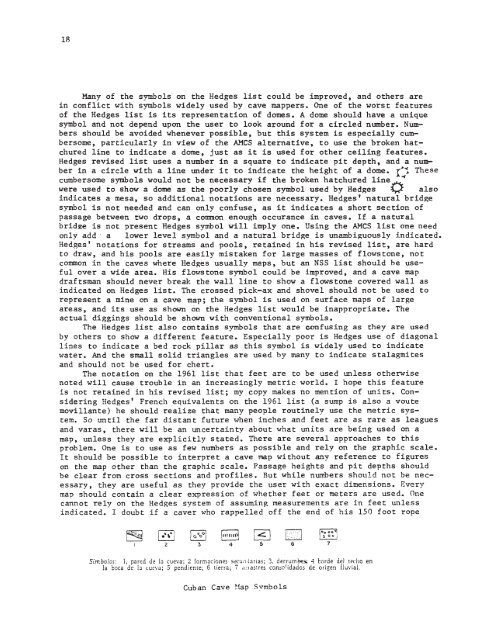asscciation for mexican cave studies box 7672 ut station austin ...
asscciation for mexican cave studies box 7672 ut station austin ...
asscciation for mexican cave studies box 7672 ut station austin ...
- No tags were found...
Create successful ePaper yourself
Turn your PDF publications into a flip-book with our unique Google optimized e-Paper software.
18Many of the symbols on the Hedges list could be improved, and others arein conflict with symbols widely used by <strong>cave</strong> mappers. One of the worst featuresof the Hedges list is its representation of domes. A dome should have a uniquesymbol and not depend upon the user to look around <strong>for</strong> a circled number. Nu~bers should be avoided whenever possible, b<strong>ut</strong> this system is especially cumbersome,particularly in view of the AMCS alternative, to use the broken hatchuredline to indicate a dome, just as it is used <strong>for</strong> other ceiling features.Hedges revised list uses a number in a square to indicate pit depth, and a numberin a circle with a line under it to indicate the height of a dome. r- 1 Thesecumbersome symbols would not be necessary if the broken hatchured line~~were used to show a dome as the poorly chosen symbol used by Hedges ~ alsoindicates a mesa, so additional notations are necessary. Hedges' natural bridgesymbol is not needed and can only confuse, as it indicates a short section ofpassage between two drops, a common enough occurance in <strong>cave</strong>s. If a naturalbrid2e is not present Hedges symbol will imply one. Using the AMCS list one needonly add· a lower level symbol and a natural bridge is unambiguously indicated.Hedges' notations <strong>for</strong> streams and pools, retained in his revised list, are hardto draw, and his pools are easily mistaken <strong>for</strong> large masses of flows tone , notcommon in the <strong>cave</strong>s where Hedges usually maps, b<strong>ut</strong> an NSS list should be usefulover a wide area. His flows tone symbol could be improved, and a <strong>cave</strong> mapdraftsman should never break the wall line to show a flows tone covered wall asindicated on Hedges list. The crossed pick-ax and shovel should not be used torepresent a mine on a <strong>cave</strong> map; the symbol is used on surface maps of largeareas, and its use as shown on the Hedges list would be inappropriate. Theactual diggings should be shown with conventional symbols.The Hedges list also contains symbols that are confusing as they are usedby others to show a different feature. Especially poor is Hedges use of diagonallines to indicate a bed rock pillar as this symbol is widely used to indicatewater. And the small solid triangles are used by many to indicate stalagmitesand should not be used <strong>for</strong> chert.The notation on the 1961 list that feet are to be used unless otherwisenoted will cause trouble in an increasingly metric world. I hope this featureis not retained in his revised list; my copy makes no mention of units. ConsideringHedges' French equivalents on the 1961 list (a sump is also a vo<strong>ut</strong>emovillante) he should realize that many people ro<strong>ut</strong>inely use the metric system.So until the far distant f<strong>ut</strong>ure when inches and feet are as rare as leaguesand varas, there will be an uncertainty abo<strong>ut</strong> what units are being used on amap, unless they are explicitly stated. There are several approaches to thisproblem. One is to use as few numbers as possible and rely on the graphic scale.It should be possible to interpret a <strong>cave</strong> map witho<strong>ut</strong> any reference to figureson the map other than the graphic scale. Passage heights and pit depths shouldbe clear from cross sections and profiles. B<strong>ut</strong> while numbers should not be necessary,they are useful as they provide the user with exact dimensions. Everymap should contain a clear expression of whether feet or meters are used. Onecannot rely on the Hedges system of assuming measurements are in feet unlessindicated. I doubt if a <strong>cave</strong>r who rappelled off the end of his 150 foot rope841 c::: I0·..····: :-;:',':-5 6Simbolos: 1, pared de In cueva; 2 <strong>for</strong>mociones secul1,}orias; 3. derrumbe!l; 4 corde del techo en1a boca de Ia luevo; 5 pendieme; 6 tierra; 7 a:Hstres cOn:i()lidados de origen fluvial.Cuban Cave Hap Svmbols
















